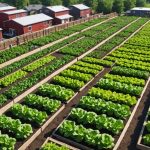Introduction to Eco-Transforming Real Estate
Eco-transforming real estate is a growing trend reshaping the urban landscape with an emphasis on sustainability and innovative practices like sustainable urban farming. The integration of these elements is crucial in making urban development more environmentally friendly and economically viable.
The Significance of Integration
Incorporating sustainability in real estate development addresses urgent ecological concerns and sustainable practices can result in long-term financial benefits. Developers are increasingly exploring eco-friendly materials and energy-efficient designs to reduce their environmental footprint. This evolution is not just about doing the right thing but also about positioning themselves as leaders in a rapidly changing market.
Also to read : Maximizing Sunlight: Cutting-Edge Home Design Strategies for Northern Climates
Overview of Urban Farming Concepts
Sustainable urban farming has become a cornerstone of urban planning, offering cities a chance to produce food locally, reducing transportation emissions. These farming practices include rooftop gardens, vertical farms, and community-supported agriculture (CSA), all aimed at rethinking how space in cities is utilized. Local communities benefit greatly, as these practices can improve food security and boost engagement.
Emerging Trends
Trends in eco-friendly urban development include a focus on mixed-use spaces combining residential, commercial, and agricultural elements, creating vibrant communities. Innovations like smart irrigation systems and renewable energy sources are part of a broad strategy to enhance urban environments, ensuring they are both ecologically and economically sustainable.
In parallel : Mastering Eco-Friendly Insulation: Top Techniques for Maximum Efficiency in UK Weather
Benefits of Integrating Sustainable Urban Farming in Real Estate
Integrating sustainable urban farming within real estate offers numerous economic advantages for both developers and communities. Developers experience reduced operational costs by utilizing resources efficiently and incorporating green technologies. These practices increase property values and attract eco-conscious consumers looking for sustainable living environments.
Environmentally, urban farming plays a crucial role in mitigating the negative impact of urban sprawl. By reducing transportation emissions, as fresh produce is grown locally, the carbon footprint of food distribution is significantly decreased. Additionally, urban farming contributes to biodiversity preservation and improved air quality, enhancing the overall environmental health of urban settings.
Socially, sustainable urban farming fosters a sense of community engagement and strengthens local connections. Urban farms provide educational opportunities and promote awareness about environmental issues, encouraging residents to participate in sustainable practices. Moreover, by enhancing food security, urban farming ensures access to fresh and nutritious produce, particularly in areas known as food deserts.
In conclusion, the integration of urban farming into real estate developments is not merely a trend but a strategic approach that underscores the interconnectedness of economic, environmental, and social benefits. This multifaceted strategy ensures that both current and future generations can thrive in sustainable, vibrant communities.
Case Studies of Successful Urban Farming Integration
Examining urban farming case studies reveals the transformative potential such projects hold for real estate. A notable example includes the DakAkker rooftop farm in Rotterdam, which combines agriculture with social cohesion by offering a green escape in the urban heart. The farm demonstrates how space can be optimally utilised to grow vegetables and fruits, reduce carbon emissions, and involve the community.
In Chicago, the Plant showcases an innovative approach, recycling a former meatpacking facility into a vertical farm. Its success lies in creating a zero-waste environment while fostering local job creation and enhancing food security.
From these examples, several lessons emerge. Firstly, effective collaboration with local governments and communities is crucial for successful integration. Secondly, the projects highlight the importance of adaptive use of space, turning underused areas into productive sites. Lastly, a commitment to local engagement ensures wider acceptance and support, essential for long-term sustainability.
Moreover, these case studies underscore the diverse economic benefits, like increased property values and cost savings from reduced transportation needs. Environmentally, they exemplify a reduction in urban heat and improved biodiversity, demonstrating how sustainable urban farming is not just feasible, but indispensable.
Practical Strategies for Developers and City Planners
Integrating urban farming in real estate requires practical strategies that developers and city planners can confidently employ. Understanding these strategies can lead to the successful development of eco-transforming real estate and promote sustainable practices.
First, developers should adopt a step-by-step approach, beginning with the assessment of urban spaces to identify potential locations for farming initiatives. This includes examining rooftops, underused spaces, and vertical surfaces that can be repurposed for agricultural activities.
Engaging in collaboration with local governments and community organizations is crucial. These partnerships provide support for regulatory compliance and ensure that projects align with community needs and preferences. Local governments can offer incentives, such as tax reductions, to promote sustainable developments.
Additionally, ensuring compliance with local zoning laws and regulations is essential to avoid legal setbacks. This involves consulting legal experts to navigate zoning restrictions and obtain necessary permits. This diligence helps in overcoming regulatory barriers effectively.
By implementing these practical strategies, developers and city planners can create innovative, sustainable urban environments. Such commitment not only benefits the community but also positions stakeholders as pioneers in an increasingly environmentally conscious market.
Challenges in Integrating Urban Farming into Real Estate
When integrating urban farming within real estate developments, there are several challenges that developers and city planners commonly face. Key among these are financial constraints, as initial investments in sustainable technology and infrastructure can be significant. Addressing these financial challenges requires innovative financing models, such as public-private partnerships or community-supported initiatives, to make urban farming economically viable.
Logistical barriers are also prevalent. Incorporating farming practices within urban settings often necessitates thoughtful planning to utilise space optimally without disrupting existing urban layouts. Access to water, sunlight, and the structural capacity of buildings for rooftop gardens are important considerations. Planners need to design solutions that balance urban density with productive agricultural spaces.
Moreover, overcoming regulatory hurdles can be a challenge. Urban farming requires navigating complex zoning laws and obtaining the necessary permits. To tackle these logistical challenges, effective collaboration with governmental bodies is essential to advocate for policy adjustments that support sustainable farming initiatives.
Through strategic planning and collaboration, these obstacles can be surmounted. Developers and city planners are encouraged to innovate and create proactive strategies that align with ecological and urban development goals. This nurture of sustainability fosters resilient and adaptive cities for the future.
Future Trends in Eco-Transforming Real Estate
The future of eco-transforming real estate is marked by several innovative trends that promise to revolutionise urban landscapes. As technology continues to advance, its role in enhancing urban farming capabilities becomes increasingly significant. Smart technologies, such as automation in irrigation and pest control, offer precise monitoring and maintenance of urban farms, which ensures optimal growing conditions and resource efficiency.
Predictive data analytics can foresee produce yields and plan harvests efficiently, allowing urban farms to scale operations sustainably. Furthermore, vertical farming will gain momentum, especially in regions with dense urban populations. By utilising multi-layered crop cultivation, vertical farms maximize space usage and reduce water consumption by up to 70% compared to traditional farming.
Innovative building designs integrating green spaces, solar panels, and rainwater harvesting systems are expected to flourish. These developments enhance both ecological and aesthetic appeal in urban settings. Looking ahead, there’s a concerted push towards creating smart cities where sustainability is at the core.
Such innovations not only foster a green economy but also contribute significantly to global efforts in combating climate change, positioning sustainable urban farming as an indispensable element of real estate development in the future.
Conclusion and Call to Action
The transformation of urban landscapes through eco-transforming real estate and sustainable urban farming is an opportunity for all stakeholders to engage proactively. This call to action reaches developers, city planners, and communities alike. Embracing sustainable practices not only prepares cities to meet contemporary ecological challenges but also enhances the quality of urban life.
To further this movement, all stakeholders are encouraged to actively incorporate sustainability into their projects. Harnessing the power of urban farming is a strategic way to achieve this, promoting environmental health and boosting local economies. By doing so, stakeholders contribute to developing vibrant, future-proof cities.
Community involvement is paramount. Engaging local populations fosters a sense of collective responsibility and ensures projects align with public needs. Sustainable urban farming initiatives offer tangible benefits, including improved food security and greater civic engagement.
For those seeking to explore and enhance their understanding of integrating eco-friendly solutions, numerous resources are available. Joining local forums, attending workshops, and consulting with experts are viable methods to gain insights and further practical knowledge. Solving urban challenges starts with informed collective action, pushing forward the sustainable urban development agenda.











